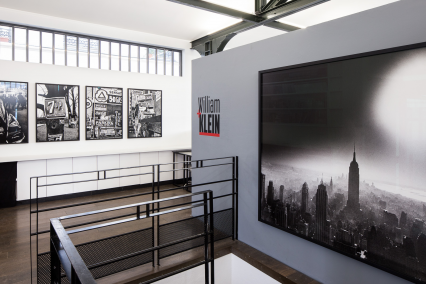Polka presents “William + Klein”, a retrospective organized in celebration of William Klein’s 90th birthday on April 19th 2018. The scenography is made up of a monumental photographic mosaic of 90 prints, retracing Klein’s oeuvre through the most decisive chapters of his practice. From his light abstractions (1948-1952) to his fashion photography (1958-2002), Klein created films, wandered the streets of New York (1954-55), Rome (1956), Moscow (1959) and Tokyo (1961), passing of course through Paris, his adopted home. The exhibition’s selection pays homage to the most French-hearted of American photographers, following the journey of his great career, spanning 70 years of photography.
Abstract (1948-1952). Before his colossal influence on street and fashion photography, Klein was trained in abstract painting in Paris under Fernand Léger. Armed with his Rolleiflex, won in a poker game during his service in the army, photography quickly becomes his new experimental battlefield. He plays with light and geometry in the vacuum of darkness, gradually establishing a photographic vocabulary that will follow him throughout his career. Klein’s first photographic abstractions are exhibited in Milan in 1954, and have most recently been displayed at the Centre Pompidou in the exhibition “Photographisme”.
New York (1954 - 1955). Spurred by Alexander Liberman, the director of Vogue, William Klein returns to his hometown - New York City. “I was in a trance, dazed by the possibilities of what my camera could do. So I adopted the slogan ‘anything goes’. This is what has always worked for me. No rules, no prohibitions and no limits.” Klein breaks all of the medium’s established codes, flipping framing on its head, jostling angles, playing with rhythm, image succession and film grain for the first time. He revolutionizes the act of photographing. Rejected in the United States, Klein’s book Life is Good & Good for You in New York is only published thanks to Chris Marker, the director of Seuil at the time. Receiving the Nadar prize in 1957, the book is now considered a key founding text in the history of 20th century photography.
From Rome, to Tokyo, Paris and Moscow (1956-2002). New York brings the first chapter of Klein’s body of work to a close. The second opens with an exploration of four major cities: Rome, Moscow, Tokyo and Paris. They are the heros of his travel diaries, documenting a world tour that lasts for forty years. Klein discovers the winding streets and the great authors of Rome at Fellini’s side as his assistant. He meets his mentors at the café Rosati on the Piazza del Popolo, among them Pier Paolo Pasolini, Ennio Flaiano, Alberto Moravia and Giangiacomo Feltrinelli. The next leg of his trip takes him to Moscow. The American photographer ventures onto enemy territory at the peak of the cold war… yet somehow he remembers being “[…] surprised and shaken. I hate New York, but I love Moscow. This city touched me most of all, stirring my heart”. Two years later in 1961 he travels further still to the east, this time on an official invitation from the Japanese authorities to photograph their largest megalopolis. By then his work on New York and Rome is already well known in Tokyo. Thus his vision of photography inspires the greatest of that Japanese generation: Nobuyoshi Araki, Daïdo Moriyama and Eikoh Hosoe.
Fashion. In 1958 Klein signs a contract with Vogue. His colleagues are Irving Penn and Richard Avedon. It is there, on the pages of fashion magazines that the photography of the period flourishes. Far from the shackles of photographic conservatisms, visionary artistic directors take the reins. Klein immediately takes advantage of the opportunity, bringing his models out of the studio and down into the swarming, bright streets. They pose while life continues flowing around them; and he observes from afar through his telephoto lens. In 1994 Klein’s book In & Out Fashion is published alongside his exhibition at the ICP in New York City.
Portraits + Friends. William Klein goes on to photograph a series of celebrity portraits for Vogue and Harper’s Bazaar. His subjects invlude Brigitte Bardot, Audrey Hepburn, Jeanne Moreau, Jean-Luc Godard and Serge Gainsbourg. Among the exhibited selection are multiple never-before-seen prints.
“Typo” + Films. At times Klein’s conceptual angle of a fine artist takes over his photography. He appropriates the street, twisting its artifacts of peeling billboards, cement blocks and neon lights into photographic ready-mades. On the other side of the medium’s spectrum, the exhibition investigates his cinematography, displayingreproductions of his films’ posters.
Contacts + Klein (1990-2014). This recent series of unique pieces meshes photography with cinema, graphic design and painting, embodying William Klein’s complex and multifaceted relationship with the medium. Selecting three negative stills at a time through his enlarger, Klein recreates his own cinematographic sequence, his “three-shot film”, sealing it in with a thick framework of painted brushstrokes. The artist reproduces the archetypal gesture of a photographer in front of his contact sheet, emphasizing the importance of his selection. Numerous painted contact sheets punctuate this anniversary exhibition.
For more information please contact us at communication@polkagalerie.com

